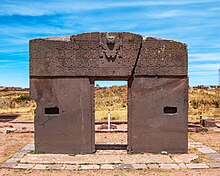
Back تيواناكو Arabic تيواناكو ARZ Tiwanaku AST Tiwanaku Aymara Tiuanako Azerbaijani Тиуанако Bashkir Тыўанака Byelorussian Тиуанако Bulgarian তিওয়ানাকু সভ্যতা Bengali/Bangla Tiahuanaco BS
 The "Gate of the Sun" | |
| Alternative name | Tiahuanaco, Tiahuanacu |
|---|---|
| Location | Tiwanaku Municipality, Bolivia |
| Coordinates | 16°33′17″S 68°40′24″W / 16.55472°S 68.67333°W |
| Type | Settlement |
| History | |
| Founded | c. 110 AD?[1] |
| Cultures | Tiwanaku empire |
| Site notes | |
| Condition | In ruins |
| Official name | Tiwanaku: Spiritual and Political Centre of the Tiwanaku Culture |
| Type | Cultural |
| Criteria | iii, iv |
| Designated | 2000 (24th session) |
| Reference no. | 567 |
| Region | South America |
Tiwanaku (Spanish: Tiahuanaco or Tiahuanacu) is a Pre-Columbian archaeological site in western Bolivia, near Lake Titicaca, about 70 kilometers from La Paz, and it is one of the largest sites in South America. Surface remains currently cover around 4 square kilometers and include decorated ceramics, monumental structures, and megalithic blocks. In AD 800 the site has been conservatively estimated to have been inhabited by 10,000 to 20,000 people.[2]
The site was first recorded in written history in 1549 by Spanish conquistador Pedro Cieza de León while searching for the southern Inca capital of Qullasuyu.[3]
Jesuit chronicler of Peru Bernabé Cobo reported that Tiwanaku's name once was taypiqala, which is Aymara meaning "stone in the center", alluding to the belief that it lay at the center of the world.[4] The name by which Tiwanaku was known to its inhabitants may have been lost as they had no written language.[5][6] Heggarty and Beresford-Jones suggest that the Puquina language is most likely to have been the language of Tiwanaku.[7]
- ^ Marsh, Erik (2012). "A Bayesian Re-Assessment of the Earliest Radiocarbon Dates from Tiwanaku, Bolivia". Radiocarbon. 54 (2): 203–218. Bibcode:2012Radcb..54..203M. doi:10.2458/azu_js_rc.v54i2.15826.
- ^ Janusek, John (2004). Identity and Power in the Ancient Andes: Tiwanaku Cities through Time. New York: Routledge. p. 128. ISBN 978-0415946346.
- ^ Kolata, Alan L. (1993). The Tiwanaku: Portrait of an Andean Civilization. Wiley-Blackwell. ISBN 978-1-55786-183-2.
- ^ Kelley, David H.; Milone, Eugene F. (November 19, 2004). Exploring Ancient Skies: An Encyclopedic Survey of Archaeoastronomy. Springer. ISBN 978-0-387-95310-6.
- ^ Hughes, Holly (October 20, 2008). Frommers 500 Places to See Before They Disappear (500 Places). Frommers. pp. 266. ISBN 978-0-470-18986-3. Retrieved 9 August 2009.
- ^ "Profile: Fabricio R. Santos - The Genographic project". Genographic Project. National Geographic. Archived from the original on July 5, 2011. Retrieved 2009-08-09.
- ^ Heggarty, P.; Beresford-Jones, D. (2013). "Andes: linguistic history". In Ness, I. (ed.). The Encyclopedia of Global Human Migration. Oxford: Wiley-Blackwell. pp. 401–409. doi:10.1002/9781444351071.wbeghm852. ISBN 978-1-44435-107-1.
© MMXXIII Rich X Search. We shall prevail. All rights reserved. Rich X Search
